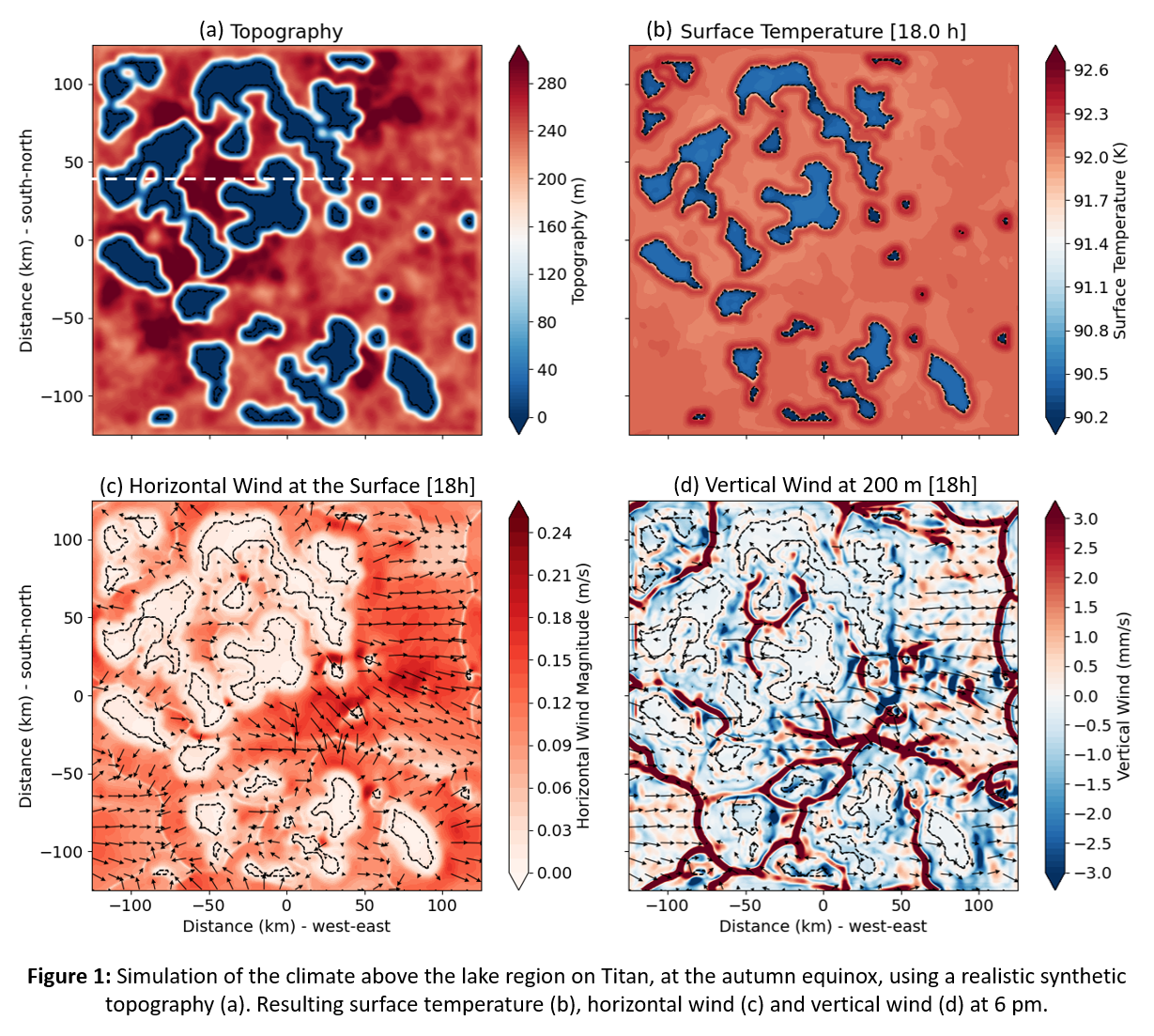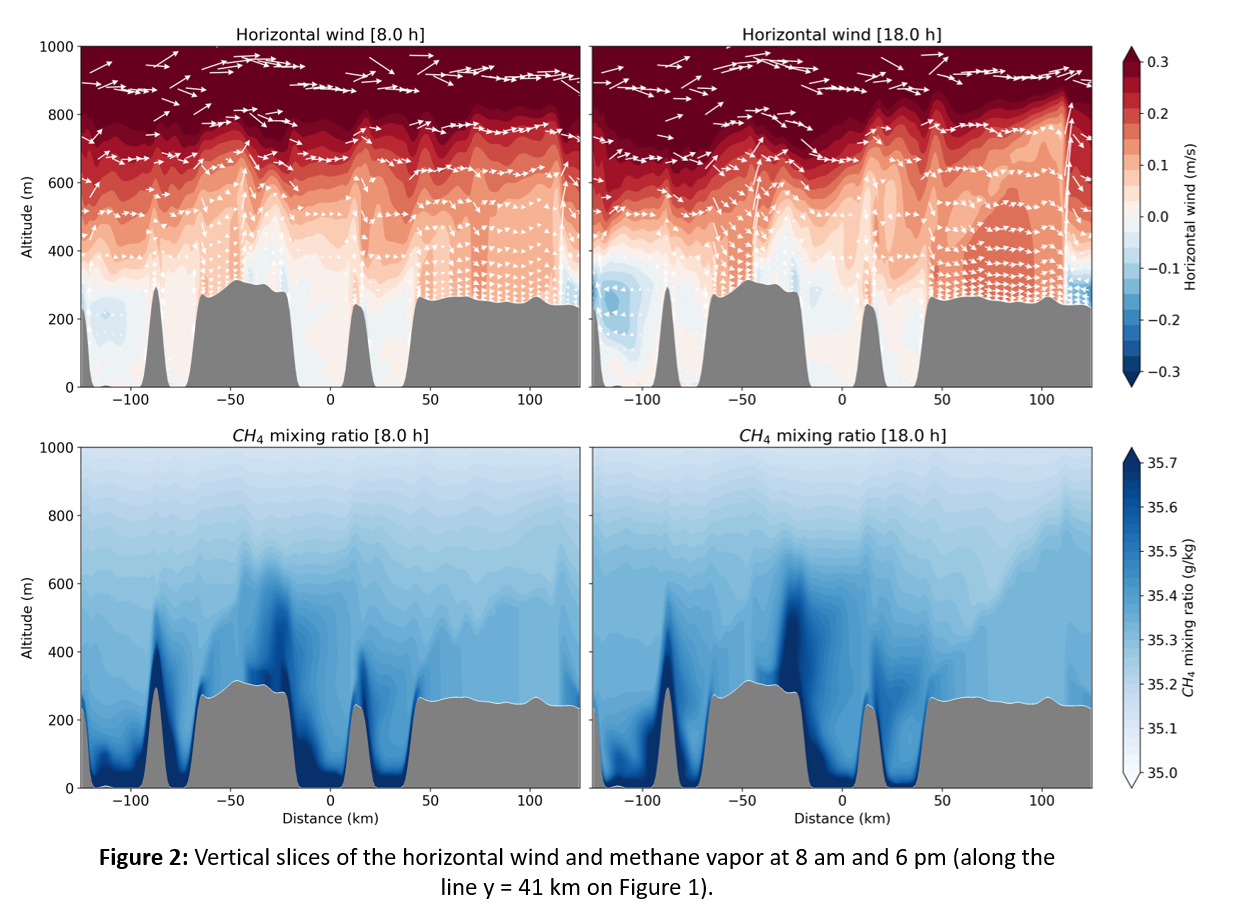Modelling the climate in Titan’s lake regions
- 1LATMOS/IPSL, CNRS, Université Paris-Saclay, UVSQ, Sorbonne Université, Guyancourt, France (audrey.chatain@latmos.ipsl.fr)
- 2LMD/IPSL, Sorbonne Université, CNRS, Paris, France
- 3Department of Space Studies, Southwest Research Institute, Boulder CO, USA
- 4Cornell Center for Astrophysics and Planetary Science, Cornell University, Ithaca, NY, USA
- 5Department of Earth and Planetary Sciences, Yale University, New Haven, CT, USA
- 6Departamento de Física Aplicada, Escuela de Ingeniería de Bilbao, UPV/EHU, Bilbao, Spain
Titan interestingly has many similarities with the Earth. It has a thick atmosphere, made mostly of dinitrogen, and a surface pressure of 1.5 bar. It also hosts a hydrological cycle similar to the water cycle on Earth, but based on methane. We then observe similar landscapes and weather processes as on Earth: clouds, rain, rivers, lakes, seas (Hayes, 2016, Ann Rev EPS; Turtle et al., 2018, GRL)… Although we gathered many observations of Titan with the Cassini-Huygens mission, the conditions at its surface are still mostly a mystery. How strong are the winds? What are the variations of the surface methane humidity? How frequent are clouds? What is their distribution in size? How frequent is rain? The NASA Dragonfly mission will have many meteorological sensors to probe the weather on Titan in the mid 2030s (Barnes et al., 2021, PSJ). Nevertheless, we need to have sounded expectations of the surface conditions, lower troposphere properties and relevant processes to prepare the drone and its instruments.
For this purpose, we are developing a mesoscale climate model of the troposphere and the surface of Titan. This model is based on the WRF (Weather Research and Forecasting) model developed by NCAR for Earth weather predictions. We call it mtWRF (“mesoscale Titan WRF”). To adequately reproduce the methane cycle, we start by focusing on the evaporation of methane from the surface and its transport by local winds. We made several studies on the climate around a lake on Titan, improving step by step the model, with focuses on the cooling effect of lake evaporation (Rafkin & Soto, 2020, Icarus), the diurnal influence of radiations (Chatain et al., 2022, PSJ), the effect of lake shape and groups of lakes (Chatain et al., 2024, Icarus), and the effect of surface properties and topography (Moisan et al., PSJ, in rev, detailed in another abstract).
These works showed that lakes cool down by evaporating methane into the atmosphere. This creates a very stable, moist and cold marine layer above the lake. Winds are very small over the lakes, but breezes form on the shore from the differential horizontal air temperature, blowing from the lake to the land. Their intensity and horizontal extend vary diurnally with the insolation. The lake breezes are also affected by background large-scale winds, nearby lakes and topography.
We are now starting to compute the climate above selected regions of Titan, including realistic lake distribution and topography. The first region of interest we chose, 250-km-wide and centered on (128.5°W, 73.5°N), includes many small lakes surrounded by plains, without any mountains. Based on the Cassini synthetic aperture Radar (SAR) dataset, we make a simplified geomorphological map with only three units: lakes (200 m deep), SAR-dark plains, and SAR-bright plains (100 m higher than the dark ones). Units’ heights are estimated from available SARTopo and Radar altimetry data in the region, and a random fractal topographic roughness is added in all regions except filled lakes (which are flat). The mesoscale model imposes two constraints on the topography: 1) it must be periodic, therefore we cut all lakes crossing the edge of the region of interest; and 2) the curvature (derivative of the slope) must remain small, so we applied a custom smoothing filter. Both the steep 1-km-wide lake rims and the broader 10—20-km-wide ramparts (Solomonidou et al., 2020, Icarus) cannot be well reproduced given the resolution and smoothing function; future work will focus on these structures with higher resolution. More details on the synthetic topography are given in another abstract by Bonnefoy et al.
Using this synthetic topography and input atmospheric profiles from the global scale Titan Atmospheric Model (Lora et al., 2022, Icarus), we are exploring the seasonality of winds, methane evaporation rate, humidity and temperatures in this lake region. First results are given in Figures 1 and 2. These results will help us understand the general absence of waves on lake observations, the possibility of fog in the depressions and the quantity of methane evaporated from the lakes into the atmosphere.


How to cite: Chatain, A., Bonnefoy, L. E., Moisan, E., Rafkin, S. C. R., Soto, A., Poggiali, V., Lora, J., Spiga, A., Lefèvre, M., and Hueso, R.: Modelling the climate in Titan’s lake regions, Europlanet Science Congress 2024, Berlin, Germany, 8–13 Sep 2024, EPSC2024-180, https://doi.org/10.5194/epsc2024-180, 2024.